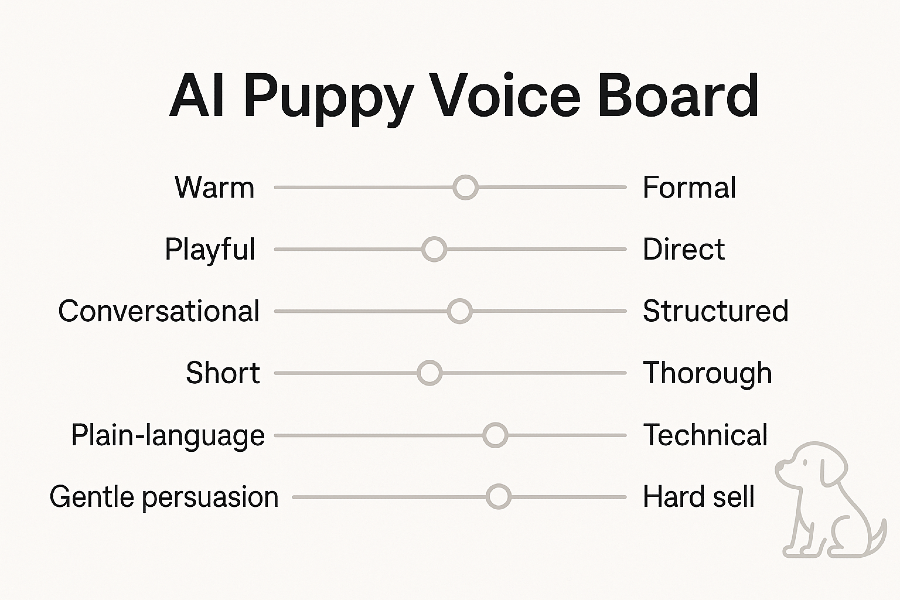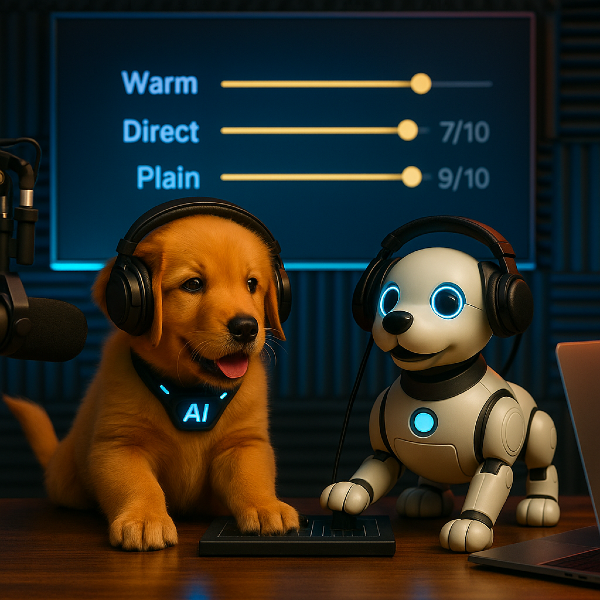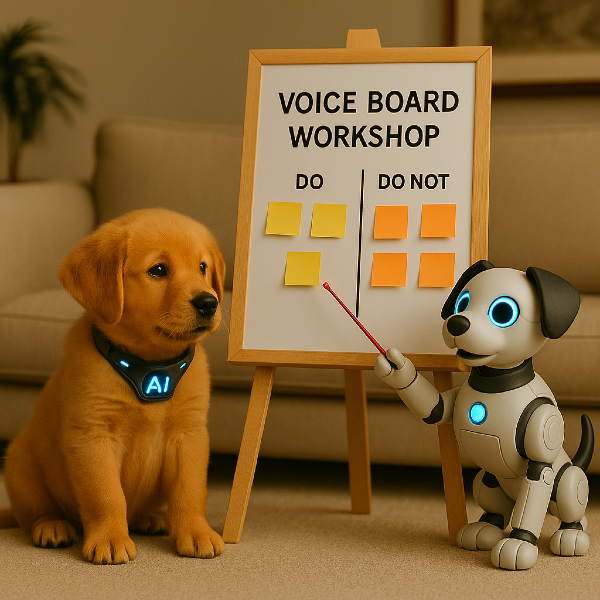Train Your AI Puppy’s Voice
Build a one-page Voice Board to make AI copy sound like you. Do/Do-Not list, sample lines, style sliders, phrase bank, and paste-in prompts included.

Make It Sound Like You: Build a One-Page Voice Board for Your AI Puppy
Why most AI copy sounds generic (and how to fix it)
If your AI Puppy sometimes sounds like a brochure, it’s not you—it’s the missing Voice Board. A Voice Board is a single page that tells the model how you speak, what to avoid, and what “good” sounds like in your world. Instead of rewriting the same directions in every chat, you paste the board once and start from your voice, not a blank slate.
This post helps you build your board in ~30 minutes. You’ll draft a Do/Do-Not list, gather two–three sample lines, set simple style sliders (e.g., warm 8/10; direct 7/10; plain-language 9/10), and create a mini phrase bank for welcomes, CTAs, closers, and reassurances. Then you’ll get two paste-in prompts to “translate” any paragraph into your voice and to quickly check consistency.
Try it: download the worksheet, keep it open, and fill each section as you read.

Build your Voice Board in 5 parts
1) Do / Do-Not (5 each)
List behaviors you want the model to lean into—and to avoid.
- Do: short sentences, concrete examples, warm but direct, plain-language, gentle persuasion.
- Do-Not: hype, clichés, long intros, technical jargon, hard-sell language.
Tip: Write them as verbs: “Use short sentences.” “Skip long preambles.”
2) Sample lines (2–3 that sound like you)
Give the model a taste of your rhythm.
- “Let’s keep this simple. Here’s the plan in three clear steps.”
- “If you’re busy, start with step one—today—and you’ll still make progress.”
Short, specific, and human. Two or three lines are plenty.

3) Style sliders (circle or set numbers)
Sliders make tone adjustable without long explanations. Pick a number for each pair:
- Warm 1–10 Formal
- Playful 1–10 Direct
- Conversational 1–10 Structured
- Short 1–10 Thorough
- Plain-language 1–10 Technical
- Gentle persuasion 1–10 Hard sell
Example setting: warm 8/10; direct 7/10; plain-language 9/10; short 7/10; conversational 7/10; gentle persuasion 8/10.
4) Mini phrase bank (2–3 go-tos per use case)
Pre-approved phrasing speeds up revisions and keeps voice consistent.
- Warm welcome: “Glad you’re here.” “Let’s start small and make it doable.”
- Soft CTA: “Try the first step now.” “When you’re ready, grab the worksheet.”
- Direct CTA: “Download the worksheet.” “Save this and use it today.”
- Close: “You’ve got this.” “One step at a time.”
- Reassurance: “Plain-language, zero jargon.” “No fancy tools required.”
5) Voice cues your audience trusts
List words your readers like—and ones that feel off-brand.
- Use: simple, clear, step-by-step, example, checklist, friendly
- Avoid: unlock, embark, leverage, ninja, ultimate, crush

Paste-in prompts (copy these)
Tone Translation
“Act as my voice editor. Voice Board: [paste]. Sliders: warm 8/10, direct 7/10, plain 9/10. Rewrite the text to match this voice. Keep meaning, short sentences, no clichés. Return one paragraph (120–150 words).”
Consistency Check
“Check this draft against my Voice Board + phrase bank. List 5 edits to improve consistency, then apply them. Keep length within ±5%.”
A quick example (before → after)
Before (generic):
“Unlock your potential with these transformative strategies that will revolutionize your workflow.”
After (with your Voice Board):
“Let’s keep this simple. Pick one small change that saves you ten minutes a day. Start with the checklist, then try the example. You’ll feel the difference this week.”
Notice the shift: plain-language, short lines, specific benefit, and your phrases.

10-minute tune-up checklist
- One-line promise in the opener
- Short sentences (read it out loud once)
- One concrete example
- Ban the hype words (add to your Do-Not list)
- Replace big words with plain ones (use your phrase bank)
What to do next
- Fill the worksheet and save your board as a PDF and a text snippet.
- Paste it at the top of your next chat (keep it pinned for that thread).
- Test the prompts: run Tone Translation on a paragraph you already wrote.
- Use it across channels: blog, email, captions—same voice, less rewriting.
Download the Voice Board Worksheet (PDF)
📘 AI Mastery for Life & Business
Discover how to make AI work for you — even if you're not tech-savvy. This beginner-friendly guide walks you through using tools like ChatGPT to simplify your life, create digital products, stay organized, and unlock creativity at any age.
- ✔️ Build smarter routines with less stress
- ✔️ Use AI for content, planning, and productivity
- ✔️ Designed especially for midlife and beyond
📬 Want more personalized guidance, focused content, and member-only tools?
Subscribe to my free newsletter and get access to exclusive resources, weekly insights, and practical tools to help you thrive in life, business, and wellness using simple AI support. You’ll get content that’s created just for subscribers — not shared anywhere else.
This resource is for educational and lifestyle inspiration only. While I share how I personally use tools like ChatGPT, I am not a certified tech expert. Use AI at your own pace and comfort level, and consult a professional for technical advice as needed.
💌 Haven’t joined the Plant Based Flex blog yet?
It’s completely free, and when you confirm your email, I’ll send you my 7-Day Kickstart Wellness Bundle to help you start thriving beyond 60.
